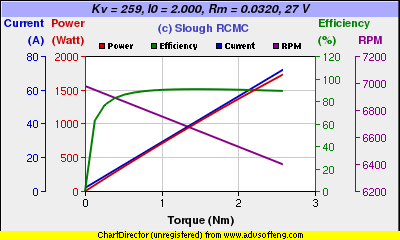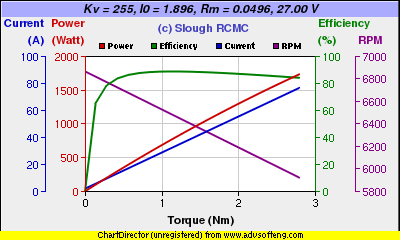

 |
 |
Making Motor Measurements |
Many people have commented that putting manufacturers data into typical motor calculation software often results in predictions that do not even come close to reality. There are several reasons for this:
What effect does this inconsistency between Rm, Ri, and I0 have?
Let us consider an example; an AXI5330/18 The data quoted by the manufacturer is
Using these figures in a classical DC motor calculation at 27V with an APC 19x12 Electric prop would yield the following:

If however real measurements of the motor performance are used, in order to calculate the varying I0 with voltage/RPM and the Rm, such as with voltprop or Drive Calculator the following is found:

You will notice that the second set of figures leads to much more realistic results with lower RPM, Current and Efficiency.
How do I get a more realistic Rm, Ri, and I0 measurement?
The minimum data necessary for a realistic motor calculation are two no-load voltage, current and RPM points, as well as voltage, current, and RPM at two operating points under strongly different loads (small prop, high rpm, small current - large prop, low rpm, high current). The under load operating voltages should not differ by more than 20%, if possible.
Both voltprop or Drive Calculator use a common database format so that data generated for one can be used in the other; making it easier for modellers to share and compare motor data.
For all measurements; these should be taken at WOT (Wide Open Throttle) in order to avoid errors!
How do I make these 'unloaded' measurements?
An 'unloaded' measurement means a measurement of the voltage, current and RPM without any load (prop) being fitted to the motor. For all voltage measurements the voltage should be measured at the ESC for a brushless motor. The current and voltage may be measured using a common Watt meter that most electric modellers have.
Measurement of the RPM with no prop fitted is slightly more tricky as there is nothing for the tacho to register from! There are three techniques that can be sued to measure the 'unloaded' RPM of a brushless motor:

Please perform the unloaded measurements at operating temperature. The quiescent current of the ESC must be subtracted from all current data.
How do I make these 'loaded' measurements?
An 'loaded' measurement means a measurement of the voltage, current and RPM with a load (prop) being fitted to the motor. For all voltage measurements the voltage should be measured at the ESC for a brushless motor. The current and voltage may be measured using a common Watt meter that most electric modellers have.
Please perform the measurements at operating temperature, and with the throttle wide open (WOT) in order to minimise errors. The quiescent current of the ESC must be subtracted from all current data. While not more than five data records can be registered in the "Motors" list, it is advisable to do some additional measurements in order to have alternative data ready.
The best results will be achieved by providing data for three measurements under different loads - best if one of these is with zero-load, thus an 'unloaded' measurement. I.e the voltage should be the same (within 20%) but the current drawn be across the operating current range of the motor
Are you ready to do the measurements?
In order to help make motor measurements accessable for other users; an on-line submission form has been created here.
Data submitted on-line will be distributed with 'Drive Calculator' for the benefit of all. Continuous data base updates will be provided on www.elektromodellflug.de/datenbank/.
If you are ready, enter your data here: Submission Form